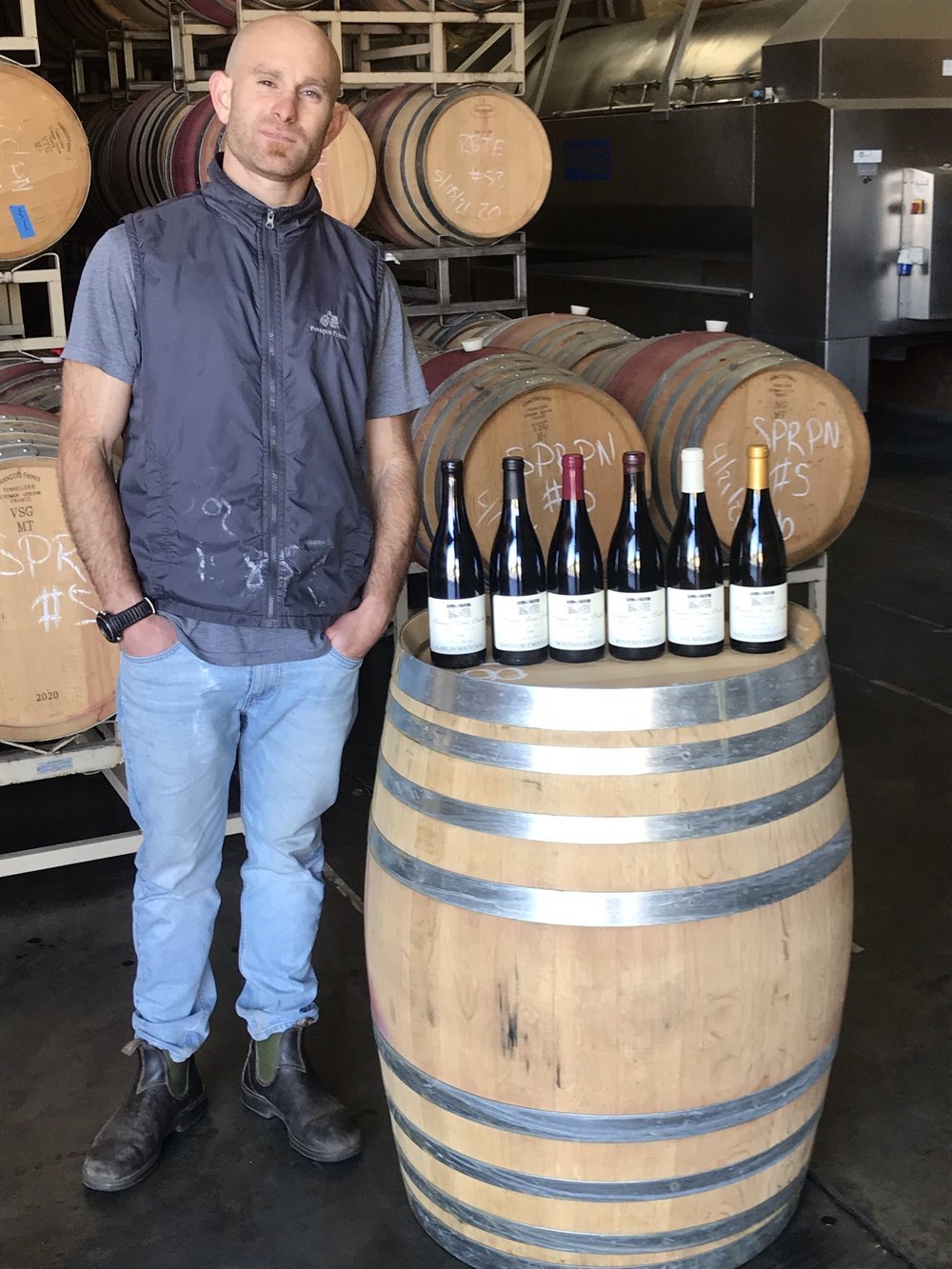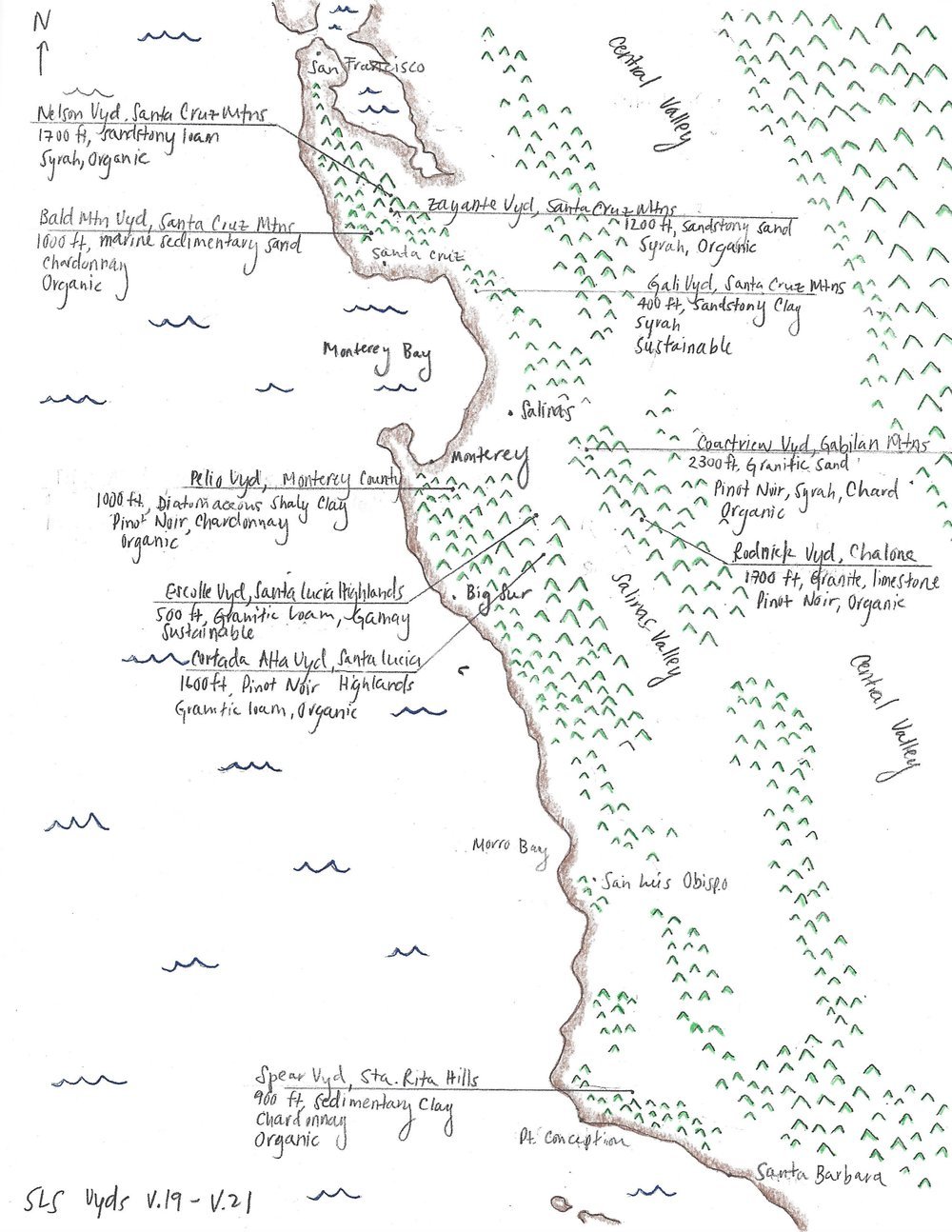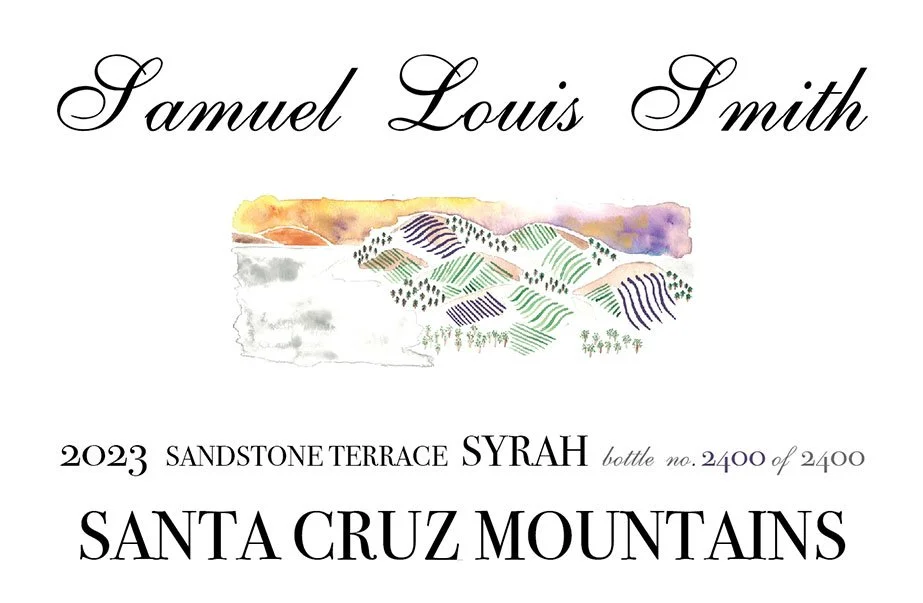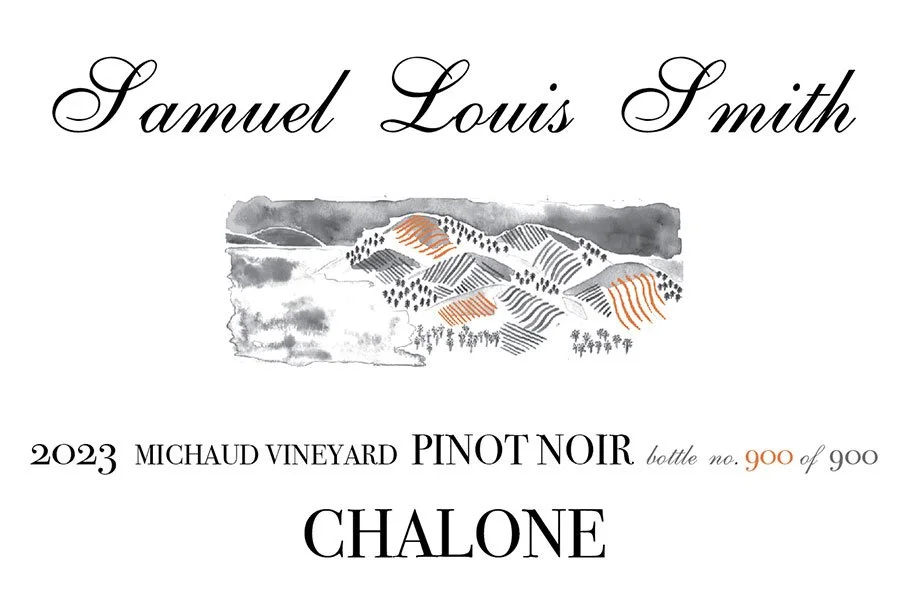
Samuel Louis Smith
Salinas, Monterey, California






"Unless you’re super into making mountain wine, it makes zero sense."
That’s how Samuel Louis Smith summed up his philosophy in a Summer 2024 interview with journalist Matt Kettmann — standing high above the fog line in the Gabilan Mountains, gazing out across the Coastview Vineyard. At 2,300 feet, in newly established AVA territory, it’s a place of extremes: ancient granite soils, piercing light, brisk mountain air, and long, slow growing seasons. It’s also where Samuel made one of the most exciting wines of the 2023 vintage — a 99-point Syrah shined a much-deserved spotlight on a quiet, underdog terroir.
Sam’s wines are all about site — expressive, restrained, and unmistakably shaped by where they come from. From wind-whipped coastal ridges to remote, granitic mountain vineyards, he’s drawn to places that test both vine and grower. His winemaking is minimal and precise, letting the intensity and tension of these fringe sites shine through.
Producing just 1,500 cases split among eight cuvées, it’s no wonder Samuel Louis Smith’s wines have flown under the radar. Working out of a shared garage in Salinas, Sam sources from a handful of organically farmed, high-elevation sites along California’s coastal mountains. Sam’s wines are precise, nervy, and deeply site-expressive: textural Chardonnays, lifted, whole-cluster Syrah and Pinot, and a juicy, Cru Beaujolais-style Gamay. The entire SLS project stands in contrast to today’s wave of overproduced custom-crush brands — it’s small, intentional, and rooted in real farming.
A native Californian, Sam caught the wine bug while studying French in Bordeaux in 2009. He worked under Doug Margerum in Santa Barbara before launching his own label in 2014, and then spent a pivotal 2015 harvest with François Villard in the Northern Rhône — where he honed his approach to whole cluster, fermentation, and freshness. By 2016, he was at Morgan and making his first Sandstone Terraces Syrah, a wine that remains central to his lineup.
Sam ferments with pied de cuve — native yeast cultures built in small batches from each vineyard — to preserve site specificity and prevent cross-contamination. For reds, he relies on tasting stems for ripeness, working with generous whole cluster when the fruit demands it. No fining, minimal filtration (for the whites) — just clarity and balance.
In a state known for power and polish, Sam is part of a new wave leaning into poise, energy, and place. His wines are some of the most exciting in California — you just might not have heard of them yet.
The 2023 vintage proved exactly why he loves these fringe sites. A record-setting winter drenched California’s coastal mountains with 130–200% of normal rainfall, pushing budbreak nearly a month late and drawing out harvest into November. It was the coldest, slowest, and one of the most challenging vintages in over a decade — and yet, it yielded wines that are among his finest. Lean, aromatic, and deeply terroir-driven, the 2023s speak with clarity and lift, capturing the energy of a historically cool season.
Across Monterey County, the Santa Lucia Highlands, the Santa Cruz Mountains, and now the Gabilans, Samuel is betting on California’s next great sites. Vineyards like Coastview, Escolle, Pelio, Michaud, Rodnick Farm, Spear, and Nelson are the backbone of this vision — and with the 2023s, the results are undeniable.
Our Selections
Samuel Louis Smith Blanc de Blancs Pelio Vineyard Monterey County 2021
Sam’s first sparkling wine takes cues from the great grower Champagnes of the Côte des Blancs and like-minded California friends. 100% Chardonnay, the grapes are picked early, fermented in steel, aged in barrel, and then bottled for secondary fermentation. It’s bottled unfined and unfiltered, followed by nearly three years of aging on the lees. Every step, from tirage to riddling and disgorging, is done by hand, with precision and care. The result is a sparkler with huge minerality, Granny Apple snap, and a layered, lees-driven roundness.
63 Cases produced | 12.0% ABV | 2.90 pH | 1g/L dosage | 95 JD
Samuel Louis Smith Chardonnay Spear Vineyard Sta. Rita Hills 2023
Planted in 2014 and farmed organically by Ofer Shepher, Spear Vineyard is one of the most exciting young sites in Sta. Rita Hills. Its steep, north-facing slopes along Highway 246 climb to 900 feet, with marine clay and sandy soils — plus a touch of chert (silex) — shaping the wines' vivid character. The SLS Chardonnay block thrives here, producing wines with bright fruit, florality, richness, and electric acidity.
Pied de cuve from the vineyard kick-starts fermentation in barrel. After alcoholic and malolactic fermentation completes, Sam opts for a nine months élévage in 17% new, 17% second-fill, and 66% neutral oak. The wine is then bottled unfined and unfiltered.
In the glass: pale yellow with notes of white flowers, crème brûlée, sea breeze, and vanilla bean, finishing with hints of salted butter and anise. Medium-bodied, fresh, and seamless.
148 Cases produced | 13.0% ABV | 3.27 pH | 95pts JD / 96pts WE
Samuel Louis Smith Chardonnay ‘Les Granitiers’ Gabilan Mountains 2023
A finely etched Chardonnay from granite-rich, high-altitude vineyards in Monterey County (Coastview, Escolle, and Pelio). Fermented in stainless steel and aged in 14% new oak and 86% neutral oak for nine months. Bright and saline, with notes of apricot, lemon zest, and sea breeze. Beautifully restrained coastal Chardonnay.
348 Cases produced | 12.8% ABV | 3.23 pH | 96 JD / 94 WE / 91 VM
Samuel Louis Smith Gamay Escolle Vineyard Sta. Lucia Highlands 2023
From the cool, windswept slopes of northern Santa Lucia Highlands, Escolle Vineyard’s granitic soils and Monterey Bay influence set the stage for a new Gamay renaissance.
100% whole-cluster fermentation with native fermentation started by a pied de cuve from the vineyard. The wine sees nine months élévage in 100% neutral French oak barrels. After aging the wine is bottled unfined and unfiltered.
Bright red in the glass with Bing cherry, lapsang tea, dried herbs, and a floral lift. Fresh acidity, light-medium body, and a silky, lithe texture make this an irresistible cool-climate Gamay.
193 Cases produced | 12.6% ABV | 3.67 pH | 94pts JD / 95pts WE
Samuel Louis Smith Syrah Sandstone Terrace Santa Cruz Mountains 2023
Sourced from organically and sustainably farmed vineyards across the Santa Cruz and Gabilan Mountains, Sandstone Terrace showcases Syrah’s spicy, floral, and vibrant side. With sandstone and granite-derived soils and elevations up to 2,300 feet, the wine captures freshness, energy, and structure. Brambleberry, violet, rose petal, white pepper, and cured meat with fresh acidity and elegant tannins.
193 Cases produced | 12.7% ABV | 85% whole cluster | 98 JD / 95 WE
Samuel Louis Smith Syrah Coastview Vineyard Gabilan Mountains 2023
Perched at 2,300 ft in the Gabilan Mountains, Coastview is a dramatic, organically farmed site with granite-limestone soils that yield Syrah of remarkable precision and lift. Samuel’s 2023 captures it in spades: black fruit, wild game, spice, and violet etched with fresh acidity and firm tannin. Seductive, structured, and incredibly rare — just 600 bottles made.
45 Cases produced | 12.2% ABV | 100% whole cluster | 99pts JD
Samuel Louis Smith Pinot Noir Montañita de Oro Monterey County 2023
Sam showcases mountainous Monterey Pinot sites in his Montañita de Oro cuvée. With an average elevation of 1100 ft, high-toned aromatics are framed by bright fruit and elegant structure. The following vineyards were used: Pelio (40%), Michaud (34%), and Double L (26%). The wine sees nine months élévage in 11% new, 24% second-fill, and 65% neutral French oak barrels. In the glass it’s all alpine strawberry, wild cherry, and rose petal with fresh herbs, cranberry, and a sweet earthiness.
300 Cases produced | 12.5% ABV | 60% whole cluster | 96 JD / 93 WE
Samuel Louis Smith Pinot Noir Pelio Vineyard Monterey County 2022
Pelio is located just west of Laureles Grade in Carmel Valley, in what will soon be the Carmel Coast AVA. At 1,000 ft and six miles from Monterey Bay, this site is truly on the edge of viticulture. Clay loam is littered with diatomaceous shale, evidence that this area was under the sea until about 12 million years ago. Planted in 2003 and organically farmed.
69% whole cluster fermentation. Native primary and secondary fermentations. 10 months élévage in 34% new and 66% neutral French oak barrels. Unfined & unfiltered.
Deep red. Wild cherry, black plum, rose hips, and Christmas spice on the nose are followed by red and black fruits, cola, and sweet and savory spices on the palate. A medium body is framed by bright acidity and fine-grained tannins, adding depth and ageability.
72 cases produced | 12.8% Alcohol | 3.56 pH | 6.7 TA
Samuel Louis Smith Pinot Noir Double L Vineyard Santa Lucia Highlands 2023
Sam returns to a site he knows deeply from his years at Morgan: Double L Vineyard. This is Santa Lucia Highlands’s only certified organic vineyard and one part of the Morgan winery estate, where Sam previously worked as head winemaker. In the cooler northern section of the AVA, Double L is situated at 200ft-600ft elevation with perfect exposure to afternoon wind and sun. Dark red fruit, black plum, and wild cherry with espresso, spice, and floral lift. It’s one of Sam’s more muscular reds and will reward those with patience and a bit of cellar space.
47 Cases produced | 12.8% ABV | 3.52 pH | 50% whole cluster | 95 JD / 98 WE
Samuel Louis Smith Pinot Noir Michaud Vineyard Chalone 2023
From the high-desert edge of Chalone AVA, Michaud Vineyard brings a wild balance of elegance and earth. Planted at 1550ft by the former Chalone Vineyard winemaker Michael Michaud in 1995, the vineyards decomposed granite soils and the arid, high desert microclimate create Pinot Noir that’s fragrant and structured. Light red in the glass with notes of cranberry, garrigue, scorched earth, and spice. Chalky tannins, fresh acidity, and a finish that speaks of a ““cool-climate” vineyard.
73 Cases produced | 12.7% ABV | 3.78 pH | 50% whole cluster | 97 JD / 93 WE / 93 JS










